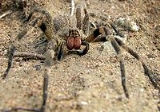
Wandering spider
Encyclopedia
The wandering spiders is a term used to refer to the spider family Ctenidae. Previously, the term referred only to the genus
Phoneutria
but now usually refers to the entire family
Ctenidae. The members of the genus Phoneutria are highly aggressive and venomous nocturnal hunters, and are the only wandering spiders known to pose a serious danger to humans. However, the venom of some other members of this family is very poorly known, meaning that all larger Ctenids should be treated with caution. Ctenids have a distinctive longitudinal groove on the top-rear of their oval carapace (some other spiders have a similar groove; e.g., Amaurobiidae).
Genus
In biology, a genus is a low-level taxonomic rank used in the biological classification of living and fossil organisms, which is an example of definition by genus and differentia...
Phoneutria
Brazilian wandering spider
Phoneutria, commonly known as Brazilian wandering spiders, armed spiders , or banana spiders , are a genus of aggressive and highly venomous spiders found in tropical South and Central America...
but now usually refers to the entire family
Family (biology)
In biological classification, family is* a taxonomic rank. Other well-known ranks are life, domain, kingdom, phylum, class, order, genus, and species, with family fitting between order and genus. As for the other well-known ranks, there is the option of an immediately lower rank, indicated by the...
Ctenidae. The members of the genus Phoneutria are highly aggressive and venomous nocturnal hunters, and are the only wandering spiders known to pose a serious danger to humans. However, the venom of some other members of this family is very poorly known, meaning that all larger Ctenids should be treated with caution. Ctenids have a distinctive longitudinal groove on the top-rear of their oval carapace (some other spiders have a similar groove; e.g., Amaurobiidae).
Genera
The categorization into subfamilies follows Joel Hallan.- Acantheinae
- Acantheis Hyatt, 1954
- Enoploctenus Simon, 1897
- Petaloctenus Jocqué & Steyn, 1997
- Acanthocteninae
- AcanthoctenusAcanthoctenusAcanthoctenus is a spider genus from Central to South America. Females in A. remotus reach a body length of about 15 mm, males at the most 11 mm.-Species:* Acanthoctenus gaujoni Simon, 1906 — Venezuela, Ecuador...
Keyserling, 1877 - Nothroctenus Badcock, 1932
- Viracucha Lehtinen, 1967
- Bengalla Gray & Thompson, 2001
- Acanthoctenus
- Calocteninae
- AnahitaAnahita (spider)Anahita is a genus of wandering spider in the family Ctenidae.-Selected species:* Anahita aakimzeda Brandt & O'Shea, 2011* Anahita fauna Karsch, 1879* Anahita jianfengensis Zhang, Hu & Han, 2011* Anahita maolan Zhu, Chen & Song, 1999...
Karsch, 1879 - Apolania Simon, 1898
- Caloctenus Keyserling, 1877
- Diallomus Simon, 1897
- Gephyroctenus Mello-Leitão, 1936
- Trujillina Bryant, 1948
- Anahita
- Cteninae
- AmauropelmaAmauropelmaAmauropelma is a spider genus that is endemic to Queensland, Australia.-Names:A. hasenpuschi is named in honor of Jack Hasenpusch of Garradunga, Innisfail, Queensland.-Species:* Amauropelma anzses Raven & Stumkat, 2001...
Raven, Stumkat & Gray, 2001 - AncylometesAncylometesAncylometes is a fishing spider genus from South America, where they live near ponds and small lakes. The spiderlings can walk over water rather fast, in a fashion similar to water striders. This is because of fine air-trapping hairs on the tips of their legs. They can dive underwater, and will...
Bertkau, 1880 - Asthenoctenus Simon, 1897
- Celaetycheus Simon, 1897
- Centroctenus Mello-Leitão, 1929
- Ctenus Walckenaer, 1805
- CupienniusCupienniusCupiennius is a spider genus.-Species:* Cupiennius bimaculatus — Venezuela, Brazil, Guyana, Ecuador* Cupiennius chiapanensis Medina, 2006 — Mexico* Cupiennius coccineus F. O. P.-Cambridge, 1901 — Costa Rica, Panama...
Simon, 1891 - Isoctenus Bertkau, 1880
- Leptoctenus L. Koch, 1878
- Thoriosa Simon, 1910
- CtenopsisCtenopsisCtenopsis is a genus of grass in the Poaceae family....
Schmidt, 1956 - Incasoctenus Mello-Leitão, 1942
- Itatiaya Mello-Leitão, 1915
- Montescueia Carcavallo & Martínez, 1961
- † Nanoctenus Wunderlich, 1988 — fossil
- † Nanoctenus longipes Wunderlich, 1988 — dominican amber
- Paravulsor Mello-Leitão, 1922
- Amauropelma
- Phoneutriinae
- Phoneutria Perty, 1833
- Phymatoctenus Simon, 1897
- Pseudoctenus Caporiacco, 1949
- Trogloctenus Lessert, 1935
- Tuticanus Simon, 1897
- Viridasiinae
- Viridasius Simon, 1889
- Vulsor Simon, 1889
- Wiedenmeyeria Schenkel, 1953
- Incertae sedisIncertae sedis, is a term used to define a taxonomic group where its broader relationships are unknown or undefined. Uncertainty at specific taxonomic levels is attributed by , , and similar terms.-Examples:*The fossil plant Paradinandra suecica could not be assigned to any...
- Janusia Gray, 1973
- Mahafalytenus Silva, 2007 — Madagascar (7 species)

